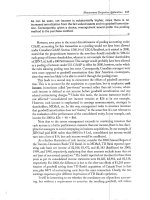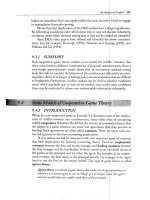Financial accounting 10th by harmin ch06
Bạn đang xem bản rút gọn của tài liệu. Xem và tải ngay bản đầy đủ của tài liệu tại đây (5.6 MB, 66 trang )
Prepared by
Coby Harmon
University of California, Santa Barbara
Westmont College
6-1
6
Inventories
Learning Objectives
6-2
1
Discuss how to classify and determine inventory.
2
Apply inventory cost flow methods and discuss their
financial effects.
3
Indicate the effects of inventory errors on the financial
statements.
4
Explain the statement presentation and analysis of
inventory.
LEARNING
OBJECTIVE
1
Discuss how to classify and determine
inventory.
Classifying Inventory
Merchandising
Company
One Classification:
Inventory
Helpful Hint
Regardless of the
classification, companies
report all inventories
under Current Assets on
the balance sheet.
6-3
Manufacturing
Company
Three Classifications:
Raw Materials
Work in Process
Finished Goods
LO 1
6-4
LO 1
Determining Inventory Quantities
Physical Inventory taken for two reasons:
Perpetual System
1. Check accuracy of inventory records.
2. Determine amount of inventory lost due to wasted raw
materials, shoplifting, or employee theft.
Periodic System
3. Determine the inventory on hand.
4. Determine the cost of goods sold for the period.
6-5
LO 1
Determining Inventory Quantities
TAKING A PHYSICAL INVENTORY
Involves counting, weighing, or measuring each kind of
inventory on hand.
Companies often “take inventory”
when the business is closed or
business is slow.
6-6
at the end of the accounting period.
LO 1
6-7
LO 1
Determining Inventory Quantities
DETERMINING OWNERSHIP OF GOODS
GOODS IN TRANSIT
Purchased goods not yet received.
Sold goods not yet delivered.
Goods in transit should be included in the inventory of the
company that has legal title to the goods. Legal title is
determined by the terms of sale.
6-8
LO 1
Determining Ownership of Goods
GOODS IN TRANSIT
Illustration 6-2
Terms of sale
Ownership of the goods
passes to the buyer when the
public carrier accepts the
goods from the seller.
Ownership of the goods
remains with the seller until the
goods reach the buyer.
6-9
LO 1
Determining Ownership of Goods
Question
Goods in transit should be included in the inventory of the
buyer when the:
a. public carrier accepts the goods from the seller.
b. goods reach the buyer.
c. terms of sale are FOB destination.
d. terms of sale are FOB shipping point.
6-10
LO 1
Determining Ownership of Goods
CONSIGNED GOODS
To hold the goods of other parties and try to sell the goods for
them for a fee, but without taking ownership of the goods.
Many car, boat, and antique dealers sell goods on consignment,
why?
6-11
LO 1
6-12
LO 1
DO IT!
1
Rules of Ownership
Hasbeen Company completed its inventory count. It arrived at a total inventory value of
$200,000. You have been given the information listed below. Discuss how this information
affects the reported cost of inventory.
1. Hasbeen included in the inventory goods held on consignment for Falls Co., costing
$15,000.
2. The company did not include in the count purchased goods of $10,000, which
in transit (terms: FOB shipping point).
were
3. The company did not include in the count inventory that had been sold with a
of $12,000, which was in transit (terms: FOB shipping point).
cost
Solution
1. Goods of $15,000 held on consignment should be deducted from the inventory
count.
2. The goods of $10,000 purchased FOB shipping point should be added to the
inventory count.
3. Item 3 was treated correctly.
6-13
Inventory should be $195,000
($200,000 - $15,000 + $10,000).
LO 1
LEARNING
OBJECTIVE
2
Apply inventory cost flow methods and
discuss their financial effects.
Inventory is accounted for at cost.
6-14
Cost includes all expenditures necessary to acquire goods
and place them in a condition ready for sale.
Unit costs are applied to quantities to compute the total
cost of the inventory and the cost of goods sold using the
following costing methods:
►
Specific identification
►
First-in, first-out (FIFO)
►
Last-in, first-out (LIFO)
►
Average-cost
Cost Flow
Assumptions
LO 2
Inventory Costing
Illustration: Crivitz TV Company purchases three identical 50inch TVs on different dates at costs of $700, $750, and $800.
During the year Crivitz sold two sets at $1,200 each. These
facts are summarized below.
Illustration 6-3
Data for inventory costing example
6-15
LO 2
Specific Identification
If Crivitz sold the TVs it purchased on February 3 and May 22,
then its cost of goods sold is $1,500 ($700 + $800), and its
ending inventory is $750.
Illustration 6-4
6-16
LO 2
Specific Identification
Actual physical flow costing method in which items still in
inventory are specifically costed to arrive at the total cost of
the ending inventory.
6-17
Practice is relatively rare.
Most companies make
assumptions (cost flow
assumptions) about which units
were sold.
LO 2
Cost Flow Assumptions
Cost flow assumptions
DO NOT need to be
consistent with the
physical movement of
the goods
Illustration 6-12
Use of cost flow methods in
major U.S. companies
6-18
LO 2
Cost Flow Assumptions
Illustration: Data for Houston Electronics’ Astro condensers.
Illustration 6-5
(Beginning Inventory + Purchases) - Ending Inventory = Cost of Goods Sold
6-19
LO 2
Cost Flow Assumptions
FIRST-IN, FIRST-OUT (FIFO)
6-20
Costs of the earliest goods purchased are the first to
be recognized in determining cost of goods sold.
Often parallels actual physical flow of merchandise.
Companies determine the cost of the ending inventory
by taking the unit cost of the most recent purchase and
working backward until all units of inventory have been
costed.
LO 2
FIRST-IN, FIRST-OUT (FIFO)
Illustration 6-6
Allocation of costs
6-21
LO 2
FIRST-IN, FIRST-OUT (FIFO)
Illustration 6-6
Allocation of costs
6-22
Helpful Hint Another way of
thinking about the calculation
of FIFO ending inventory is the
LISH assumption—last in still
here.
LO 2
Cost Flow Assumptions
LAST-IN, FIRST-OUT (LIFO)
6-23
Costs of the latest goods purchased are the first to be
recognized in determining cost of goods sold.
Seldom coincides with actual physical flow of
merchandise.
Exceptions include goods stored in piles, such as coal or
hay.
LO 2
LAST-IN, FIRST-OUT (LIFO)
Illustration 6-8
Allocation of costs
6-24
LO 2
LAST-IN, FIRST-OUT (LIFO)
Illustration 6-8
Allocation of costs
6-25
Helpful Hint Another way of
thinking about the calculation
of LIFO ending inventory is the
FISH assumption—first in still here.
LO 2









